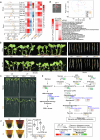Multiomics dissection of Brassica napus L. lateral roots and endophytes interactions under phosphorus starvation
- PMID: 39523413
- PMCID: PMC11551189
- DOI: 10.1038/s41467-024-54112-5
Multiomics dissection of Brassica napus L. lateral roots and endophytes interactions under phosphorus starvation
Abstract
Many plants associate with endophytic microbes that improve root phosphorus (P) uptake. Understanding the interactions between roots and endophytes can enable efforts to improve P utilization. Here, we characterize the interactions between lateral roots of endophytes in a core collection of 50 rapeseed (Brassica napus L.) genotypes with differing sensitivities to low P conditions. With the correlation analysis result between bacterial abundance and plant physiological indices of rapeseeds, and inoculation experiments on plates and soil, we identify one Flavobacterium strain (C2) that significantly alleviates the P deficiency phenotype of rapeseeds. The underlying mechanisms are explored by performing the weighted gene coexpression network analysis (WGCNA), and conducting genome-wide association studies (GWAS) using Flavobacterium abundance as a quantitative trait. Under P-limited conditions, C2 regulates fatty acid and lipid metabolic pathways. For example, C2 improves metabolism of linoleic acid, which mediates root suberin biosynthesis, and enhances P uptake efficiency. In addition, C2 suppresses root jasmonic acid biosynthesis, which depends on α-linolenic acid metabolism, improving C2 colonization and activating P uptake. This study demonstrates that adjusting the endophyte composition can modulate P uptake in B. napus plants, providing a basis for developing agricultural microbial agents.
© 2024. The Author(s).
Conflict of interest statement
Figures






References
-
- Herrera-Estrella, L. & López-Arredondo, D. Phosphorus: The underrated element for feeding the world. Trends Plant Sci. 21, 461–463 (2016). - PubMed
-
- Plaxton, C. W. & Shane, M. W. Annual Plant Reviews Volume 48: Phosphorus Metabolism in Plants, Vol. 48 (Wiley & Sons, 2015).
-
- Adu, M. O. et al. A scanner-based rhizobox system enabling the quantification of root system development and response of Brassica rapa seedlings to external P availability. Plant Root11, 16–32 (2017).
-
- Vance, C. P., Uhde-Stone, C. & Allan, D. L. Phosphorus acquisition and use: critical adaptations by plants for securing a nonrenewable resource. N. Phytol.157, 423–447 (2010). - PubMed
-
- López-Arredondo, D. L., Leyva-González, M. A., González-Morales, S. I., López-Bucio, J. & Herrera-Estrella, L. Phosphate nutrition: improving low-phosphate tolerance in crops. Annu. Rev. Plant Biol.65, 95–123 (2014). - PubMed
Publication types
MeSH terms
Substances
Associated data
LinkOut - more resources
Full Text Sources
Miscellaneous

